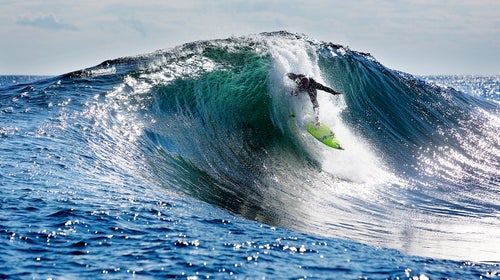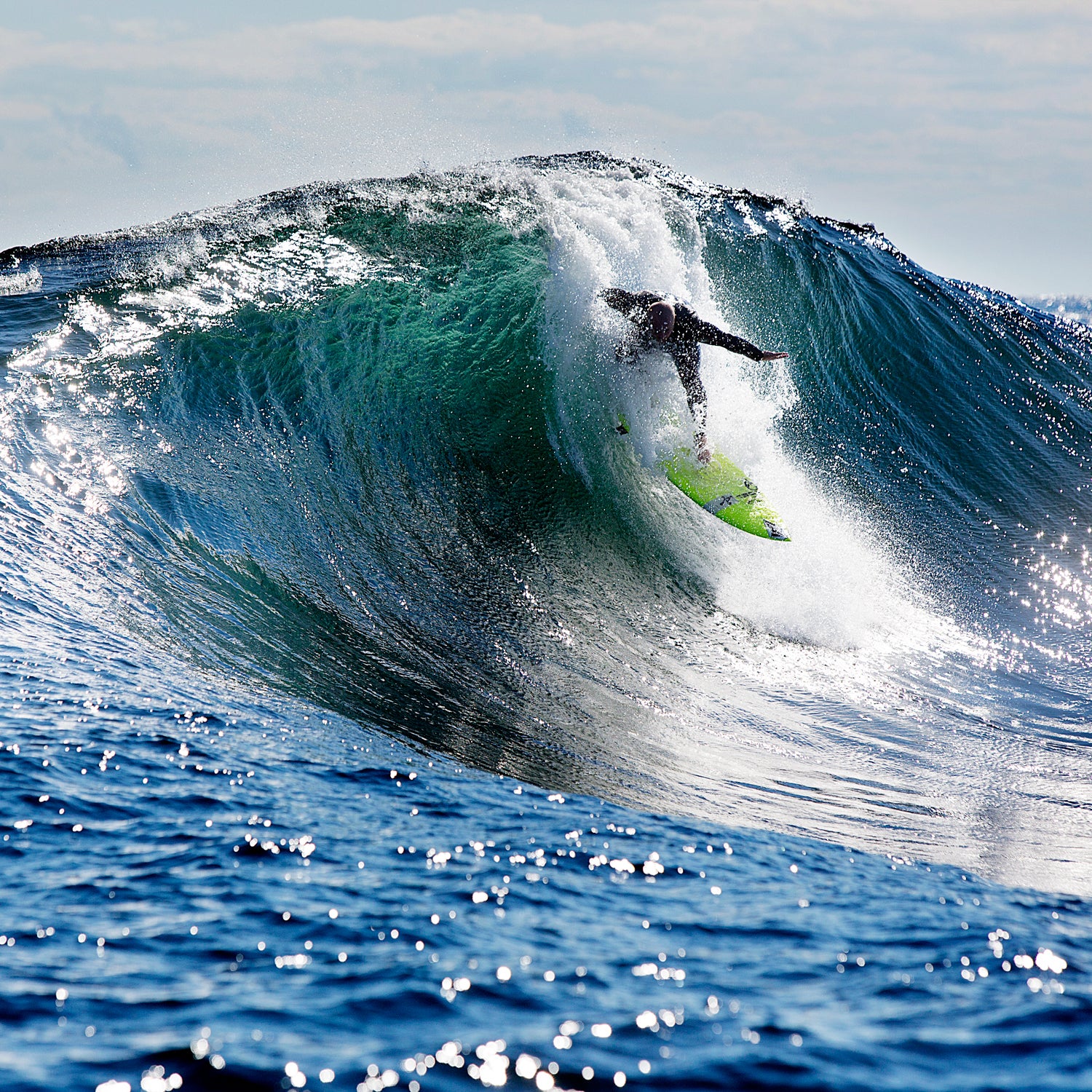“It’s bigger than I thought it was going to be,” Mike Gleason says after catching a glimpse of the waves at his home break. “It’s cleaner too.”
The wind is offshore. A haze clings to the ocean, but is burning off with the morning sun around 10 a.m. on this weekday in late March. The waves are shoulder-to-head-high. They crash on the sandbar with a thud. They drown out the Johnny Cash song playing inside Gleason’s 2004 Jeep Grand Cherokee. He’s in the driver’s seat, wearing a light blue t-shirt, faded jeans, and black Nikes. “Wow, it’s way bigger than I thought,” he repeats in between spits of chewing tobacco.
For those not familiar with Gleason’s location, the reaction might be disbelief rather than surprise. He isn’t in California or Hawaii. He is in Long Branch, New Jersey.
“Some people don’t even know that New Jersey has a coast let alone waves,” says Pat Schmidt, a 20-year-old pro surfer from Manasquan, New Jersey, who, like Gleason, is sponsored by Volcom.
When most people imagine a perfect day of surfing, they probably envision tropical, turquoise-colored water and palm trees swaying in the foreground. Gleason has a different ideal. This morning it’s 53 degrees and the water hovers around 40. “It’s gorgeous out,” Gleason says. The conditions are balmy by his standards. He’s accustomed to surfing in frigid temperatures and water that looks more like an IPA. In the Northeast the best waves often coincide with the harshest weather. That was the case in January when Gleason drove two hours north to Long Beach, New York, for one of the season’s biggest swells courtesy of Winter Storm Jonas. After hunkering down in a motel room for 24 hours, Gleason trudged through two feet of snow on the beach to get to the waves. He surfed overhead, barreling waves for an hour and a half despite 30 mph winds and pelting snow. “When a snowflake hits your eye, it burns,” Gleason says. “Oh my God, it burns. But there were only eight of us out in the water and it was absolutely firing.”
He came back the next day and surfed five hours.
“It is a special breed that really embraces the conditions,” says Billy Hume, Volcom’s East Coast marketing manager. “The guys up here are a bit of psychopaths. They will paddle out when it’s two foot and 25 degrees and they still love it.”
Gleason thrives when the conditions are most inhospitable and has garnered respect as one of the best surfers from the Garden State. His reputation, though, isn’t confined to the East Coast. He’s landed photos in national surfing magazines, was ranked by Red Bull last year, and starred in Volcom’s feature surf film—Psychic Migrations. At 31 years old, Gleason’s surfing continues to progress.
“It doesn’t matter where you go in the world, you’re never going to experience a true Jersey day that is firing. It’s so dang perfect.”
After checking two nearby spots, Gleason goes back to the first. He turns left onto a sand covered side street and passes six “NO PARKING ANYTIME” signs. He doesn’t seem to notice, or care, and stops in front of a battered bulkhead.
“In the summer the people who live here will call the cops,” Gleason says—motioning to a three-story modern beachside home. “But for now it’s cool.” He wrangles his wetsuit out of the trunk. It has an attached hood and is five millimeters thick, as are his neoprene boots and gloves. They’re as essential to surfing year round in New Jersey as a surfboard. Gleason’s current quiver includes 17 boards. He has twice as many wetsuits.
He shimmies into the suit and pulls on the hood, covering his shaved head. His thick beard still protrudes. Gleason’s facial hair—which calls to mind a frontiersman more than a surfer—combined with his stocky, barrel-chested physique is partly why his friends gave him the nickname “” about eight years ago. But the sobriquet is also due to Gleason’s approach in the water. His turns are powerful and ferocious. When he hits the lip, he displaces water like a geyser. He while pumping through the tube. He goes right on one of the bigger waves this morning—picks up speed—then lofts an alley-oop. The 5'6″ board seems glued to his feet. He’s not wearing a leash.
“That's the only air I can usually do,” Gleason says after returning to the lineup. He pulls off his wetsuit hood. He says he’s warm. He catches another wave within a minute.
Gleason stood up on his first wave at this same beach when he was six. His father, a sales representative for a trucking company, worked as a lifeguard on summer weekends and always brought his family along. The youngest of three boys, Mike developed an affinity for the water and excelled at any sport on a board. “He’s just always had a natural style and flow,” says Bryan Gleason, Mike’s brother. Soon, the youngest Gleason was skipping soccer practice to surf in the fall. He started surfing in the winter when he was 12, often riding his bike to the beach then paddling out alone. When he was 17, the only Volcom team rider from the Northeast moved to California. Gleason got his spot.
Within a year, Gleason too headed west. A trip to California during Thanksgiving of his freshman year at Monmouth University when he “scored crazy waves,” convinced him to transfer to Santa Barbara City College for the next semester. Soon after that, he received an offer from Volcom to pursue surfing fulltime. He left school. He’d spend a month in Hawaii then another in California every winter along with trips to the Caribbean, Mexico, and other premier surfing destinations. But it was also around that time when he moved back to New Jersey. It’s remained a fixed-foot ever since. “I love New Jersey too much,” Gleason explains of his decision not to relocate permanently. “This is home and where I want to be. It doesn’t matter where you go in the world, you’re never going to experience a true Jersey day that is firing. It’s so dang perfect. For its size, nowhere gets as good. Every wave you’re getting a tube or have the opportunity to get one.”
That’s why Gleason calls missing a swell in New Jersey “a nightmare” and “the worst-case scenario.” He’s not alone. When Schmidt saw the forecast for the Jonas swell he was on the North Shore of Oahu. He booked the next flight home.
While Gleason initially would never turn down a trip because it offered more exposure, the landscape of surfing in New Jersey has shifted. It’s no longer the underground scene it was back in 1996 when became the first (and still only) surfer from New Jersey to qualify for the ASP (now WSL) World Championship Tour. As surf publications have gone digital, features and galleries about the Northeast appear online almost every week in the winter. “The more publicity you get the better you’re going to do,” Gleason says.
But the increased notoriety has drawbacks. Gleason remembers days when there would be only one or two photographers on the beach. Now, they often outnumber surfers, saturating the content. Carter McCoy, a photographer and Gleason’s friend, recalls countless times he’s taken a good shot of Gleason, only find minutes later that someone has posted a photo from the same angle on Instagram. “Then everybody knows where you’re at,” McCoy says. “It goes from one person to a packed lineup. It’s harder to have those secret solo sessions.” Sometimes if Gleason and his friends find a good spot to themselves, they’ll turn their phones off. Other times they’ll head north to the Cape or Maine and search for more secluded breaks. Gleason rarely ventures south. The logic is simple.
“I hate surfing in crowds,” he says.
This morning, he didn’t have to worry about that. There were only four guys in water. Gleason knew all of them. Still, he paddled out to an empty peak near a jetty with wooden pilings sticking out like acupuncture pins. Gleason hadn’t surfed in two weeks because the Atlantic had been quiet, but he’s learned to cope with the fickleness of his playing field. He bartends during the summer. He’s as passionate about fishing as surfing. If the waves are flat and the water is clear, he’ll free dive. He runs hills and swims laps, so when waves arrive, he’s ready. It also helps that he seems to have the sandbars and currents at his home break memorized even though they constantly change. He muses about topics like swell interval and direction with the attentiveness of an oceanographer.
“You can usually see the trends of what the swells are doing,” he says. “Right now we are in a bad trend.”
The lack of swell and warming conditions cast doubt over whether the inaugural Cold War would take place at Asbury Park Casino Beach. It’s not your typical surf contest. Instead, New Jersey pros Sam Hammer and Andrew Gesler selected 14 of best surfers from their home state and New York, divided them into two teams, and squared off in man-on-man heats. The limit for the waiting period was extended from March 18th to the end of the month, before it was finally called on for the 25th. “It wasn't the classic Jersey surf we wanted, but we dealt with what we had,'' Hammer about the shoulder-high waves and 50 degree temperatures. “We want this to be cold. We don't want it to be as warm as it was today. We want people to freeze their asses off.”
While Gleason likes competition “but not so much for surfing,” the Cold War was an exception. He surfed for Gesler’s team, won his heat, and helped the side to the victory and $8,000 prize. He was also named MVP. He won a grill.
Back in the water at Long Branch, a little more than a week prior to the Cold War, Gleason wasn’t concerned about if the contest would run, the next stage of his career, or even the hole in his fishing boat that needs repair. Right now, he scans the horizon. He spots a set wave. He’s in the perfect position. He waits a few seconds, then in a flurry of motion drains his hood, yanks it back on, and flips around. He takes two strokes and pops to his feet.
He disappears into the barrel.


